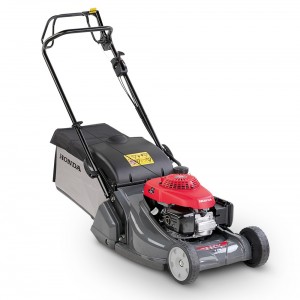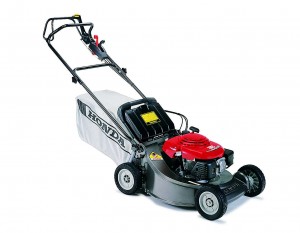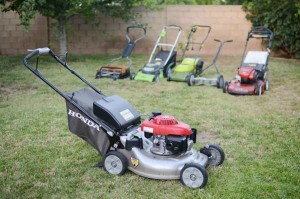The Honda HRX is arguably the best residential walk behind mower on the market, but like any outdoor equipment, it won’t last if it isn’t cared for. Here’s what you need to do to keep your mower working for years to come.
Maintenance Schedule
- Before each use: Check the blades, rear shield, blade control, grass bag, blade, oil and air filter.
- After the first 5 hours of use: Change the oil.
- After the first 25 hours of use: Clean the air filter and adjust the blade control cable and drive clutch cable.
- Every 50 hours or 6 months: Change the oil and clean the air filter.
- Every 100 hours or year: Check the spark plug, clean the spark arrester (if equipped), and check all cable adjustments.
- Every 150 hours or two years: Replace the air filter and spark plug and grease the rear wheel adjuster bushings.
Honda also recommends having the engine professionally serviced every year or 100 hours. The mechanic will check the valve clearance, idle speed and general condition of the mower.
Blades
The blades on these mowers can be handled like any other mower blade. They should be as sharp as a butter knife, and they should be replaced if the edges are worn, bent or cracked.
To access the blades, disconnect the spark plug cap and turn the fuel valve to “OFF,” then tilt the mower on its right side. Make sure the fuel cap is near the top of the mower.
When installing the blades, the curved ends of the lower blade should match up with the angled edges of the upper blade. When installing the blade bolts, the outer edge of the curved washers should face the blades. Torque the bolts to 36-43 ft-lbs.
Oil
Honda recommends 5W-30 or 10W-30 for normal operating temperatures, while SAE 30 can be used at temperatures above 50°F. The engine holds 12-13.5 oz of oil, or about a third of a quart.
The engine does not have a drain plug. To drain the oil, either use a siphon pump, or tilt the mower on its side so that the oil flows out of the filler neck into a container for recycling.
Air Filter
To access the filter, push down on the tabs on the air filter cover, then swing the cover downward.
To clean the filter, tap it against a hard surface or blow it out with compresses air. Limit the air pressure to 30 psi.
Spark Plug
The electrode gap should be between 0.028 and 0.031 inches, or 0.7 to 0.8 mm. It can be removed and installed with a 13/16 inch spark plug wrench.
When reinstalling a plug, thread it in by hand before using the wrench. Once the plug seats, turn it 1/8 to ¼ turn if it’s a used plug, or ½ turn if you’re installing a new plug. The plug should be torqued to 14 ft-lbs.
Spark Arrester
To access the arrester, remove the three flange bolts on the muffler cover, then remove the set screw holding the arrester inside the exhaust outlet.
Clean the arrester with a wire brush. If it has holes or other damage, it should be replaced. If you don’t have a spark arrester, one can be added to comply with local fire regulations.
Charging the Battery on Electric Start Models
The battery is normally charged by the engine electrical system, but it may need to be recharged after the mower has been in storage. This battery should only be charged with a Honda battery charger. Using an automotive charger will damage the battery.
1. Remove the three screws on the battery cover, located on the side of the box that houses the starter switch.
2. Slide the battery out of the box, then disconnect the wires on the battery terminals.
3. Connect the charger to the terminals, then plug the charger into a 120 volt outlet.
4. Let the battery charge for 8-24 hours. Charging for longer will damage the battery.
5. Disconnect the charger.
6. Connect the wires to the battery terminals.
7. Place the battery into the case with the terminals facing the handle. Route the wires so that they go across the top of the battery.
8. Reinstall the battery cover.
Get the Parts You Need for Your Honda Straight From Your Browser
Hondalawnparts.com is a certified Honda Engines and Power Equipment dealer, which means we can ship the OEM parts you need to maintain your HRX mower straight to your door. Select your model and serial number, and our site will show you parts that will fit your specific mower, complete with factory descriptions and exploded parts diagrams. We ship to both the U.S. and Canada.



